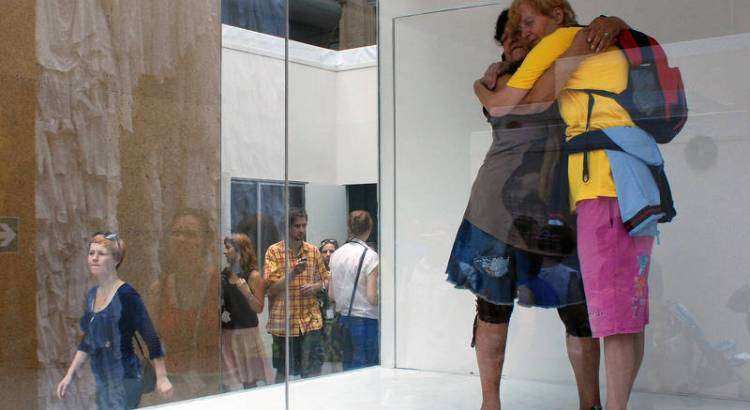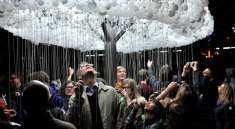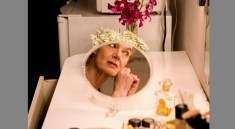PRAGUE: In Intersection, pairs of distant lovers could be spotted giving each other tight embraces inside a structure of 30 white boxes. Theater hooked up with Visual Arts. Scenography cuddled with Installation. Architecture submitted to the caprices and desires of Public Space. Spectacle kissed Intimacy’s lips.
During the 11 days of the Prague Quadrennial for Performance Design and Space in June 2011, this labyrinthine and immersive experience, conceived by Sodja Lotker for the Prague Quadrennial 2011, inhabited the Piazzetta corridor in Prague’s city center, flanked on two sides by the National Theatre of Prague and the New Stage Theatre (the former Laterna Magika).
One sunny afternoon in early June, while this architectural maze (designed by the Israeli architect Oren Sagiv) was literally being hammered into place and decorated with interactive installations, I cozied up with participating artists Guerra de La Paz, Romeo Castellucci, Monika Pormale, Brett Bailey, Nathaniel Mellors, Josef Nadj, Elevator Repair Service and Ulla Von Brandenburg to find out if their transdisciplinary romances were fixed, real, or for-one-night-only.
Seen from afar, Intersection might be a modular bee’s hive — or it might be a playground of giant toy blocks. Thirty white cubes housing 30 galleries, black-box spaces and open displays — Intersection fired up so many synapses in our brains that the journalist Jean-Marc Adolphe, in an editorial for Mouvement’s stylish-looking brochure, conjectured that it might have been a “neuronal project.”

Metaphors fly fast and furious. Intersection signaled at the crossroads of hybrid artistic expressions. It was a collective expression, a web of conceptual Euro-propositions. No — see that bar on the top floor? — this was a temporary-gallery-cum-party lounge, man. Prague was the home of Franz Kafka, whose works inscribed a labyrinth of human understanding and imagination; Intersection was therefore a maze of scenographic experiments in a public square. Brett Bailey, the charismatic director from South Africa and a jury member of this year’s Prague Quadrennial, begged to differ. “This is an installation — it is not scenography,” Bailey said. “Real scenography is what happens on stage.”
Whatever Intersection was, it took a village. Intersection is a multinational cooperation, funded by the European Union, among a congeries of European institutes, theater museums, universities and colleges, international associations of scenographers and technicians, visual art museums and theater companies. And, as it turns out, the labyrinth in Prague was not the final product. Since one goal of the project is to pursue “research” within “new contexts” (according to PQ organizers), individual projects from the boxes will be shown in major European festivals, galleries, and venues in Hungary, Serbia, Latvia, Norway, Great Britain, Italy, Estonia, Finland, and Portugal during 2011 and 2012. These events will present a smaller number of boxes (usually 3–4) that will sometimes be shown in their original boxes, while others will be fitted into fresh containers and new site-specific environments. Some of these events will embrace the participation of local artists working with Intersection ideas and spaces, accompanied by lectures and discussions.
In the month of July 2011, for example, two boxes will alight in Évora, Portugal: World of Interiors by Ana Borralho and João Galante, takes up space July 4–8, followed by Projection by Request by Bohdan Holomíček and Eva Hrubá, July 10–18, both at at Festival Escrita na Paisagem. In addition, five works from Intersection will be seen July 8 – 17 at Santarcangelo 41, one of the main international performing arts festivals in Italy, focusing this time on “the paradox of the actor’s irreducibility,” organized by Santarcangelo dei Teatri and MiBAC-DGSV.
Of course, the totality of Intersection could only have been experienced in Prague this past June. Seen from the perspective of the red-and-white trams that whiz by in front of Prague’s National Theatre and New Stage Theatre, the white boxes tucked and clustered in the Piazzetta area served as a modernist dwelling for a living mash-up. As you entered the narrow coves and wade through the narrow streets and as you strode from room to gallery room, you began to realize: This site was a lover’s nest for semi-public intimacies.

Who were the couples caught up in this torrid love affair? Meet the flirtatious lovers Visual Arts and Performing Arts. Check out the scenographers and designers who hopped into the bed of installation art, and the installation artists cavorting (some for the first time) in the splendor of scenography.
Each pair of lovers broke down perceived walls and created new convergences. The dome-like lair of Guerra de la Paz was festooned from floor to the roof with perhaps about 4,000 men’s button-down white shirts. White clothing alluded to an African Yoruba deity named Obatala, the archetypal saint of creativity. De La Paz’s partner, Alain Guerra, pointed to the pretty lacy things — prom dresses, frilly curtains and table covers — that hung inside the box. “It’s yin and yang,” said Neraldo de la Paz, who forms one half of the Miami, Florida–based duo Guerra de la Paz. “Outside, the box is more masculine. The interior is feminine.”

“Guerra De La Paz” (“war of peace”) mashes up the surnames of Alain Guerra and Neraldo de la Paz. Both men were born in Cuba. Their work references the politics of modern conflict and consumerism alongside symbols of religion and faith.
Romeo Castellucci, the celebrated Italian auteur of Societas Raffaello Sanzio, mixed cheery icons and sinister feelings. The Greek mask of comedy came to mind when he learned that Intersection sports a rooftop bar where visitors can mingle and drink. Castellucci said, “The mask is a dark mirror that looks at all of us — our society and our histories. The ancient mask of comedy has a smile on it that is quite terrifying. It suggests something about this age we live in, this terrible smile. You are alone in this room, and you can feel the judgment of this mask. The mask is a perfect negative of humanity. We are the spectacle for this mask. We are the spectacle for this theatre. We are the show!”

Castellucci is perhaps an ideal theater experimenter for Intersection, because his stage works are already an emblem of the hybrid junction between visual arts and performing arts. “Scenography is related to an action,” Castellucci stated. “The action is related to a sense of time. An installation is something outside of the dynamic of time; it is much more close to the idea of an exposition.”
British artist Nathaniel Mellors’s box — “a two-channel video installation with animatronic sculpture” — told stories. “The play concerns the medieval explorers lost inside the body of a giant and they are trying to get out,” Mellors said. Intriguingly, Mellors’ strange animatronic faces in Prague were simultaneously being exhibited at the Giardini at this year’s Venice Biennale in Italy.
Dramatic words and movement gestured throughout several Intersection boxes. Actors of the New York–based collective Elevator Repair Service performed fragments from The Sun Also Rises by Ernest Hemingway, The Sound and the Fury by William Faulkner and The Great Gatsby by F. Scott Fitzgerald. Their box, “Retrospective,” had a set of automated typewriters and plastered pages of scripts on the wall. Ben Rubin, an American media artist worked with Mark Hansen, a statistician, to create the ERS room. Rubin explained that text from the above-named 1920 novels were being fed into a mathematical algorithm, which then spat out random scripts for actors to interpret.

The splendor of dance between man and woman marked Untitled, a French–Serbian collaboration in which Anne-Sophie Lancelin and Josef Nadj created what he termed as “a choreography laboratory and a visual arts studio.” The box was built in Kanjiza (Serbia/Vojvodina), the centre of Nadj’s inspiration (the city where he was born before moving to Hungary and then later France), and then transferred to Prague and other places.
“This is choreographic/performance proposition, which implies an reflection of scenography,” Nadj said. “I found inspiration for this work in the famed Albrecht Dürer trilogy of engravings: Melencolia (1514), Saint Jerome in His Study (1514), and Knight, Death and the Devil (1513), as well as Paul Celan’s poems. For me and my partner Anne-Sophie Lancelin, due to spatial constraints, this box afforded us more possibilities than any plateau. Within the predetermined form the concept and the micro-rhythmic construction of movements were emphasized, the dance became concentrated and intensive. We are separate from the audience by window, so we cannot see the reaction of audience, we can only see their silhouettes.”
As per her usual m.o., the German-born Ulla Von Brandenburg dipped into literature, cinema, theatre and opera for inspiration. Interviewed at the Piazzetta, Brandenburg stated that she sought to re-think the role of a spectator. “I presented this traveling installation in Venice two years ago,” she said. “The box repeats the colors and spatial plans of Villa Savoye (Poissy, France), designed by Le Corbusier. I project on a fabric my film, Singspiel, which I made in this villa. As a visitor, you are somehow in a colored fabric universe to look at a black-and-white film.”
South African Brett Bailey coerces tough-minded social themes in an Intersection room that was ironically labeled a “Sanctuary.” Bailey said he is not interested in spectacle at all; he delved into the dangers of authority. “It is dark inside and very intimate,” he said. “It is very tight. You don’t know where you are going when you enter. You find that you are going upstairs. It is intended for one person at a time.” As a result, there was always a line of people that formed outside, patiently trying to get in and making “Sanctuary” perhaps one of the least inviting for masses of spectators to visit. Bailey imagined “a holy place around the altar of a Catholic Church,” he said. The piece addresses the phenomenon of priests and authority figures that have abused children.
Monika Pormale’s open box, called “Exhibit 17,” ran in thematic counterpoint to Bailey’s closed “Sanctuary.” Pormale’s interactive installation literally stages couples tightly hugging — the spectacle of shared intimacy, with hints or intimations (if viewed through a less naive and a more consumerist lens) of retailing desire and human affection. Couples who barely know each other are trapped in an aquarium-like glass box. They embrace affectionately. The rest is silence. — RG

After the Prague Quadrennial
Some INTERSECTION projects travel to European cities:
It is still possible to experience some of the Intersection boxes after the Prague Quadrennial ends in June. Starting July 2001, parts of the project are traveling to Portugal, Italy, Germany, Serbia, Latvia, Slovakia, Finland, Norway and Hungary. Here is a calendar of upcoming engagements:
July 4 – 8, Évora, Portugal
World of Interiors by Ana Borralho & João Galante, workshop and performance at Festival Escrita na Paisagem. Escrita na Paisagem - festival de performance e artes da terra, www.escritanapaisagem.net
July 8 – 17, Santarcangelo, Italy
Five Works from Intersection presented at Santarcangelo 41, one of the main international performing arts festivals in Italy, focusing this time on the paradox of the actor and on his irreducibility
Santarcangelo dei Teatri and MiBAC-DGSV, www.santarcangelofestival.com
July 10 – 18, Évora, Portugal
Projection by Request by Bohdan Holomíček & Eva Hrubá, at Festival Escrita na Paisagem. Escrita na Paisagem - festival de performance e artes da terra, www.escritanapaisagem.net
September 3 - 9, Riga, Latvia:
Seven Works from Intersection at the International Festival of Contemporary Theatre Homo Novus, looking at contemporary catastrophes, both small and intimate and large and spectacular
New Theatre Institute of Latvia, www.homonovus.lv
September 19th and 20th:
Josef Nadj, Untitled, BITEF, Belgrade (Zvezdara theatre venue) Kiosk, Regionalni kreativni atelje Jozef Nadj, BITEF, www.bitef.rs, , www.kioskngo.org
September 15 - 25, Terni, Italy:
Seven Works from Intersection at the EsTerni Festival of contemporary performing art, a platform of encounter where action, works of art, and poetics find a workroom more than a protected environment of display
EsTerni Festival of contemporary performing art, MiBAC-DGSV, www.ternifestival.it
September 23 – 28, Nitra, Slovakia:
Six Works from Intersection at the International Theatre Festival Divadelná Nitra as an echo to the theme of its 20th edition: “(don´t) tell your secret,”
International Theatre Festival Divadelná Nitra, www.nitrafest.sk
October 6 - 9, Helsinki, Finland:
Brett Bailey´s live installation EXHIBIT A at the /theatre.now Festival
Kiasma Theatre / Kiasma Museum of Contemporary Art, www.kiasma.fi
October 20 - 29, Bergen, Norway:
ThreeWorks from Intersection at the Meteor Festival in which artists from several countries meet for an art battle of dimension
BIT Teatergarasjen, www.bit-teatergarasjen.no, www.facebook.com/BITTeatergarasjen





